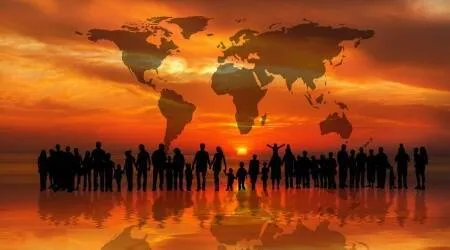
The World Population Today
The world population stands at around 8 billion today, with countries like India and China contributing to more than one-third of it. Not many know that around 10,000 BC, when agriculture first began to make a mark on Earth, the population was believed to be anywhere between 1 and 15 million. We have come a long way since then.

July 11: World Population Day
Today, July 11 is World Population Day. The theme for today is “A world of 8 billion: Towards a resilient future for all – Harnessing opportunities and ensuring rights and choices for all”. As the theme suggests, there are around 8 billion people living today but not all of them have equal rights and opportunities.

10 of the World’s Most Populous Countries
The ten most populous countries in the world in ascending order are China, India, United States, Indonesia, Pakistan, Brazil, Nigeria, Bangladesh, Russia and Mexico. Ironically, most of these countries are in Asia. For record buffs, Oceania with a population of 42 million is the least populated continent and Antarctica has about 1200 people in its various research and science stations.
Population Explosion in 300 Years
There are some interesting statistics for the increase in world population, most of which occurred in the past 300 years. This has had to do with both the agriculture and industrial revolutions and more recently with the innovations in science and medicine that has led to increased life expectancy in both infants and old people by unbelievable percentages.
How the Population Multiplied
According to the UN, the population of the world touched 1 billion for the first time in the early 1800s. From then on, it took around 125 years to double this figure in the 1920s. From then, with rapid strides in medicine and science, it reached three billion by 1960. And you know where we stand today, another 60 years later – 8 billion!
Massive Changes in Just 60 years
There is change everywhere. Our parents tell us stories about their relaxed and idyllic life in the 60s and 70s. They were rarely stuck in traffic jams. They had not heard of bans of so many kinds as we do today and for the need to save water, electricity, fossil fuels and to reduce our carbon footprint. That was when population was less than half of what it is today and life was peaceful and manageable and we were not depleting the earth’s natural resources.
Demographer's Accurate Predictions
The years in which we notched up from 3 to 4 billion was not officially recorded, but now, demographic experts can predict when the world’s population will touch each landmark figure with a high degree of accuracy. The UN declared the ‘Day of 7 Billion’ to be 31 October 2011, and predict that we will be 8 billion next year, 9 billion by 2037 and 10 by 2057. And then the good news – population will begin declining after that.
A Decline is Inevitable
The foremost important factor that will be contributing to the decline is a drop in global fertility rates around the globe. Already most of the European countries are showing a decline in population rates, besides Japan. It is predicted that the population rate in China will begin to decline by 2027. As a general trend, population rates begin declining as nations become wealthier.
Reasons for Decline in Population
When nations become wealthier, it means they have access to the best medical and research facilities. That in itself translates to increased life expectancy in children, and therefore, families need no longer depend on children as a source of family labour or for retirement welfare. As more and more women join the workforce, it has been noted that they opt to have fewer children.
Natural Causes for Decline
Sometimes, natural causes are to blame for declining population levels. This could be because of famine, war or a pandemic caused by infectious diseases. The world is in the midst of the coronavirus pandemic and already there is a report of 6.5 million deaths. This is the official figure and WHO reports suggest that this figure could be true for just India alone. Then, there are deaths because of other natural phenomena and because of emigration.































